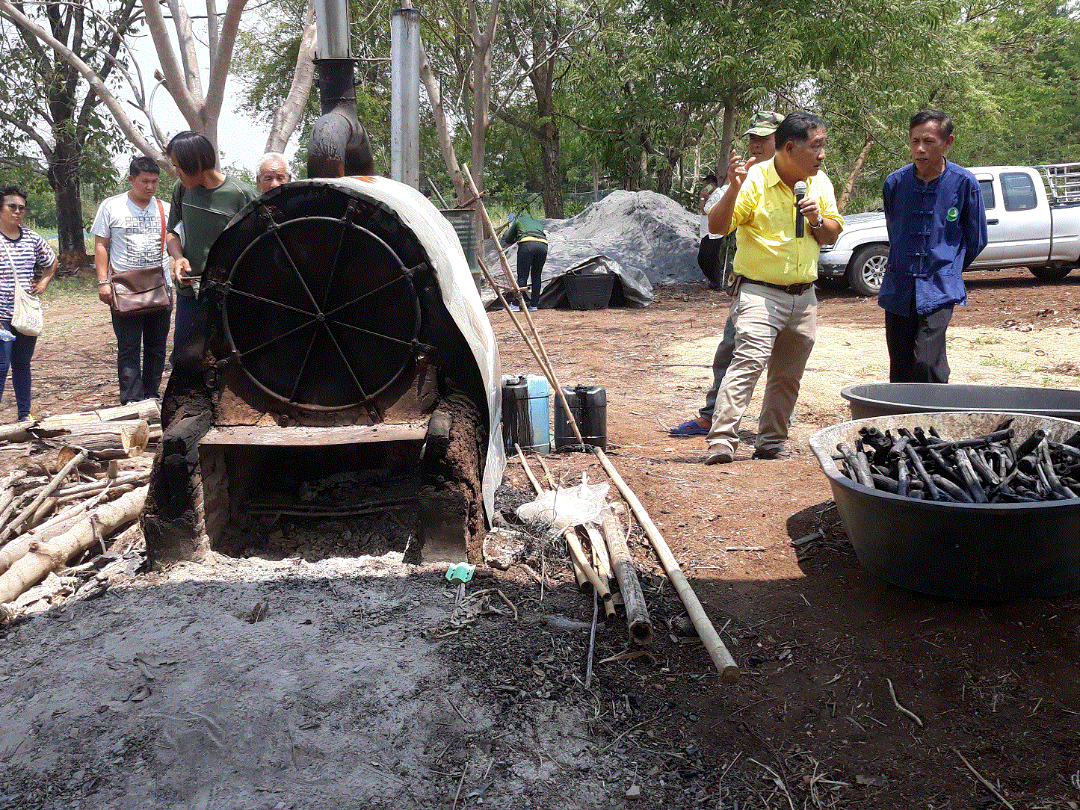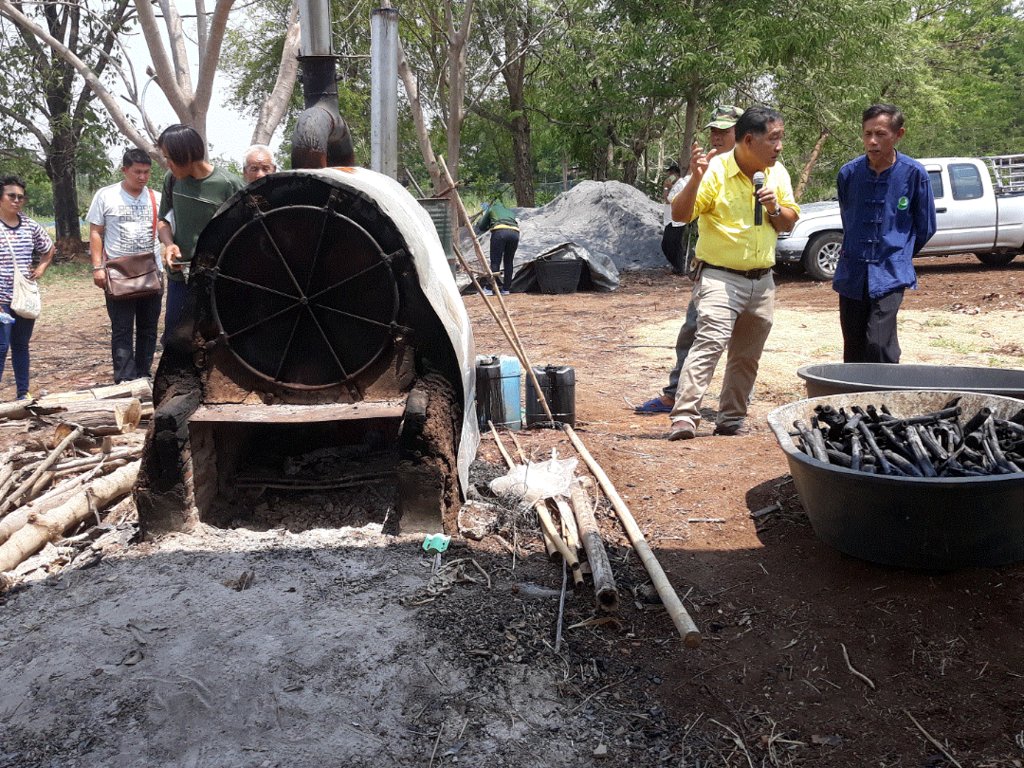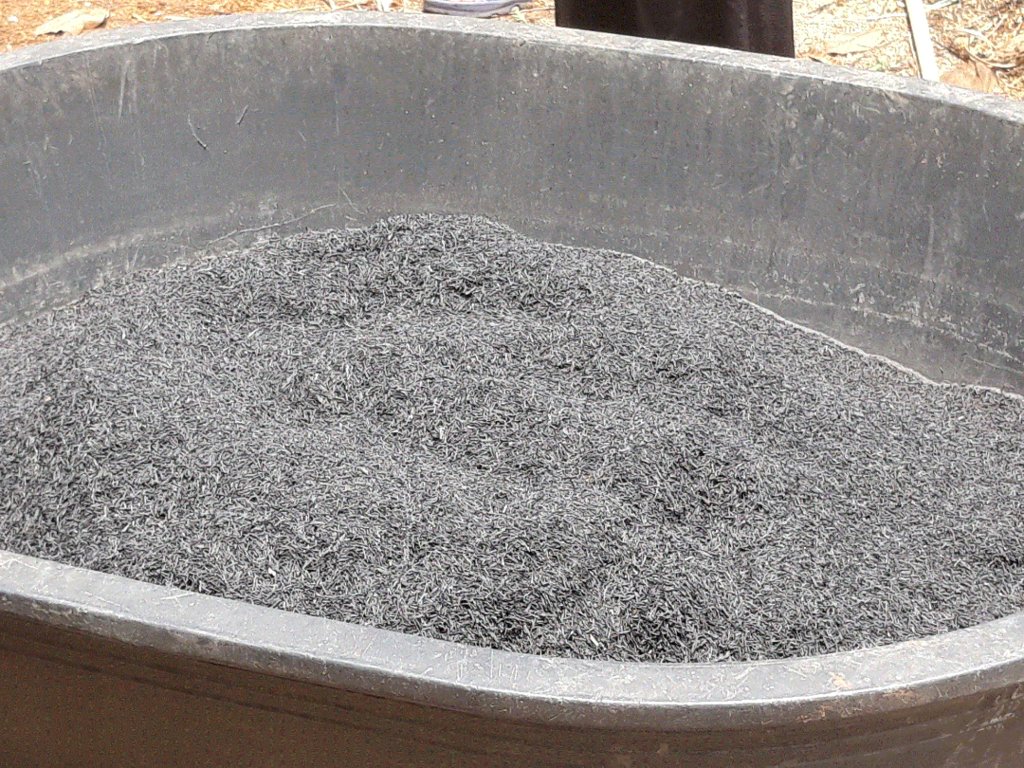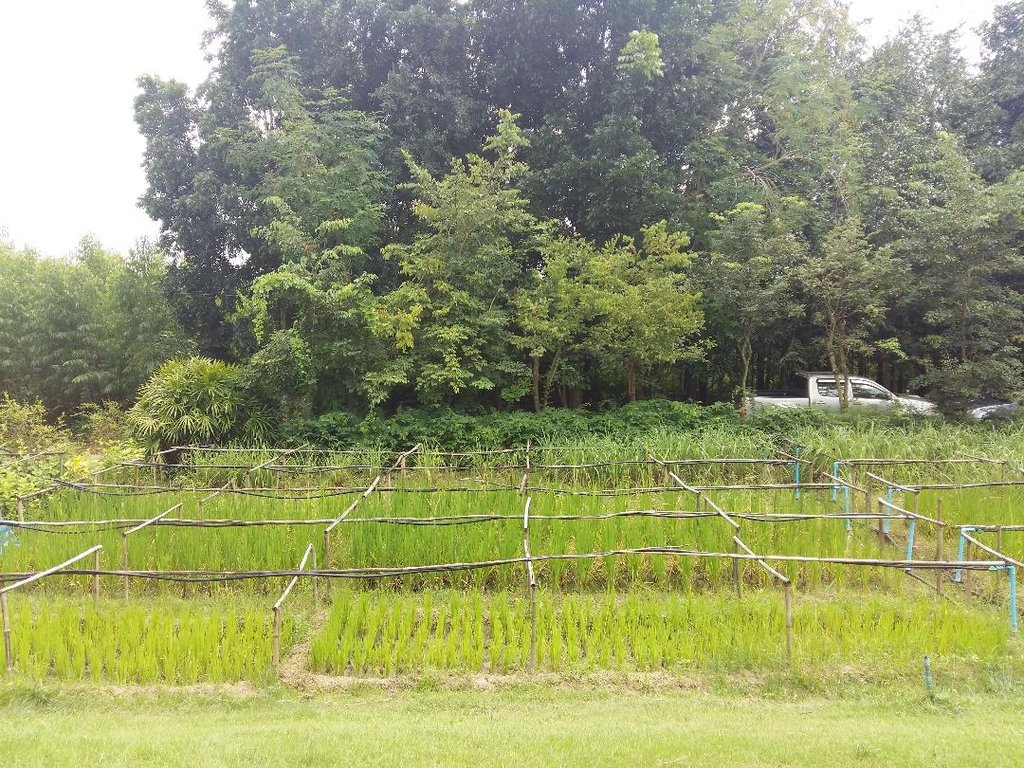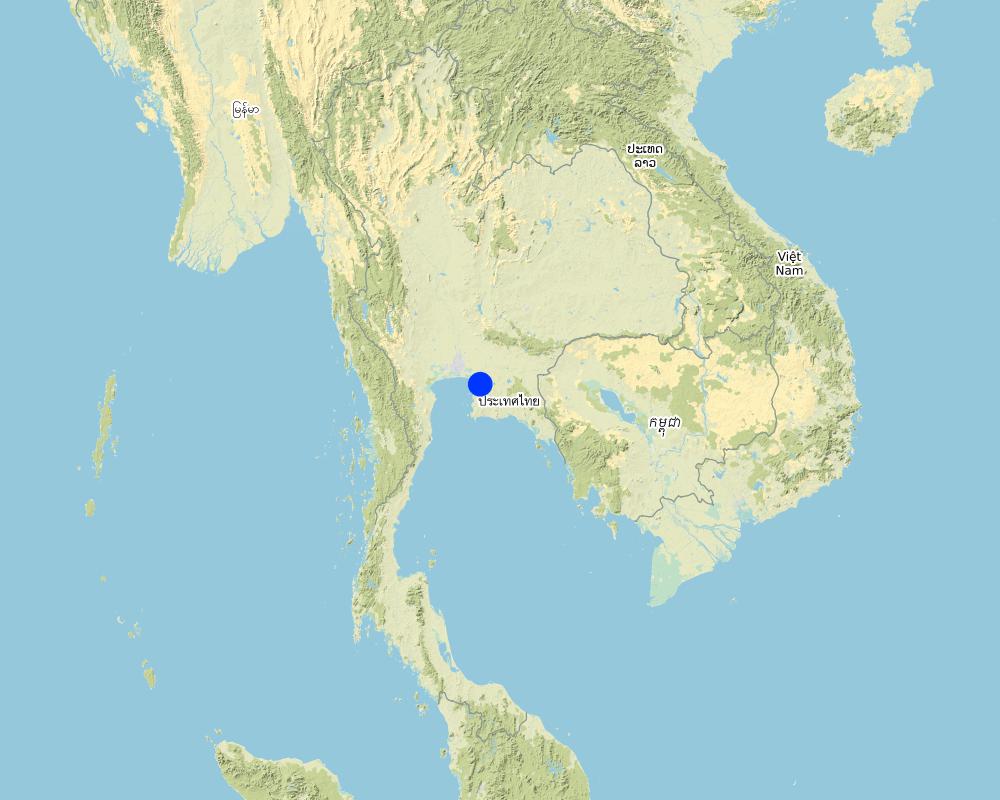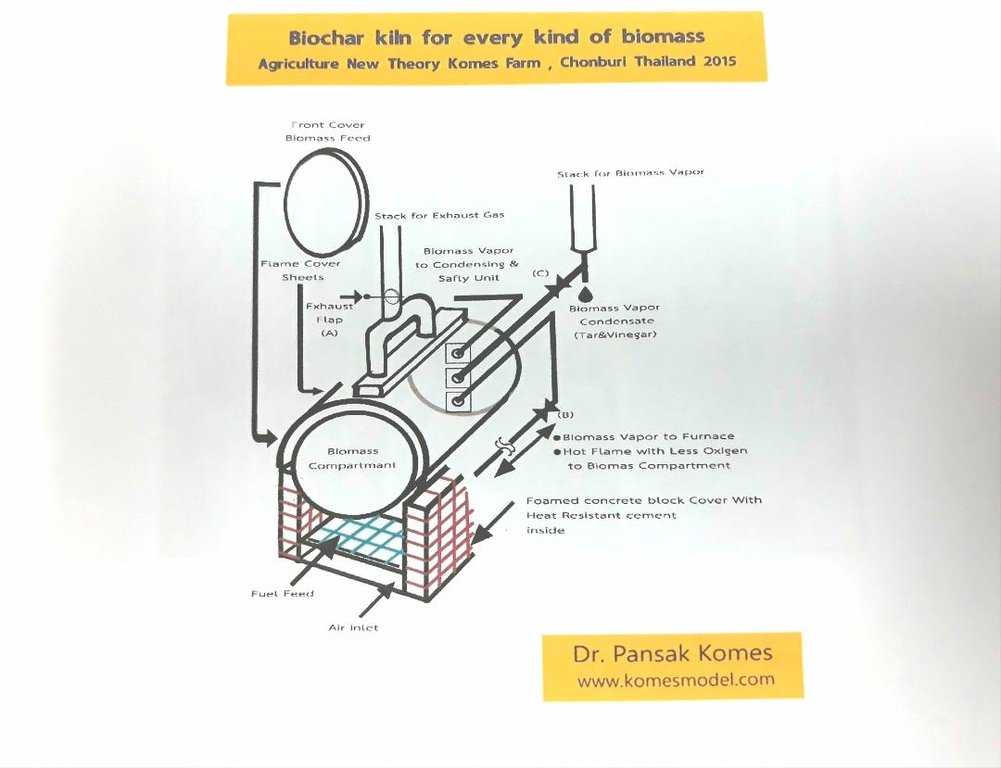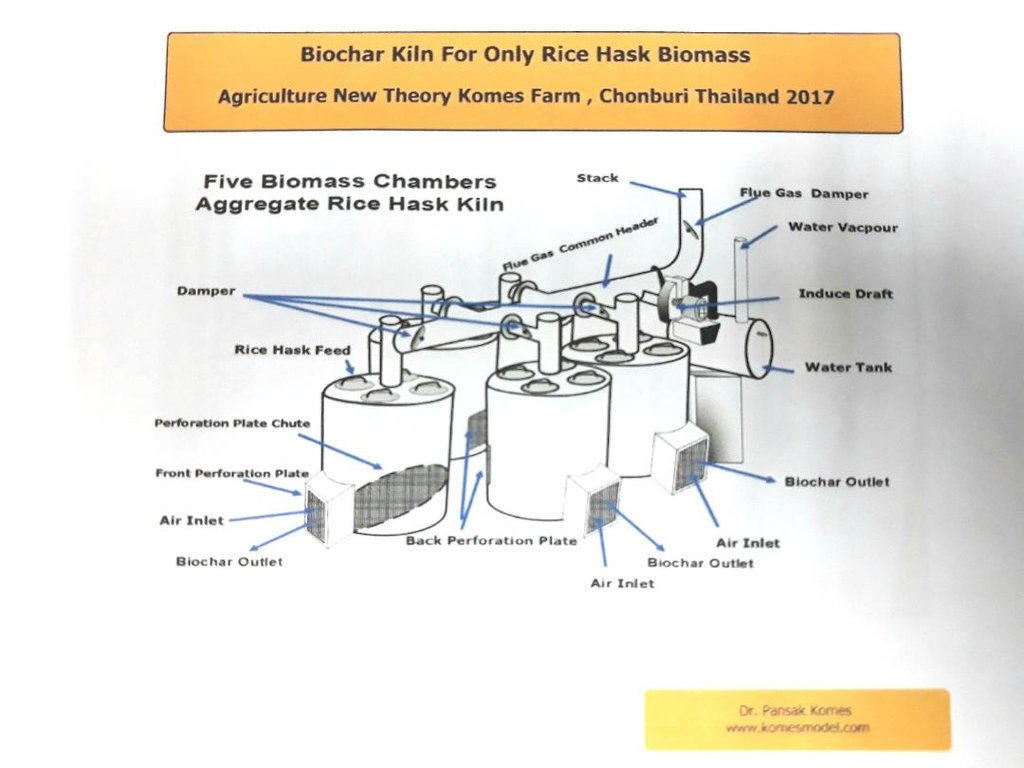Biochar application for land improvement [泰国]
- 创建:
- 更新:
- 编制者: Bunjirtluk Jintaridth
- 编辑者: –
- 审查者: Rima Mekdaschi Studer, Pitayakon Limtong, William Critchley
Biochar application for land improvement
technologies_5246 - 泰国
查看章节
全部展开 全部收起1. 一般信息
1.2 参与该技术评估和文件编制的资源人员和机构的联系方式
SLM专业人员:
Thomgcomephan Nisuda
Land Development Department
泰国
土地使用者:
Komes Pansak
Bor Kwang Tong District, Chonburi province
泰国
SLM专业人员:
Chollaket Nunthapop
Land Development Department
泰国
有助于对技术进行记录/评估的项目名称(如相关)
Environmental Land Management and Rural Livelihood Project有助于对技术进行记录/评估的机构名称(如相关)
Wageningen Agric. University (Wageningen Agric. University) - 荷兰1.3 关于使用通过WOCAT记录的数据的条件
编制者和关键资源人员接受有关使用通过WOCAT记录数据的条件。:
是
1.4 所述技术的可持续性声明
这里所描述的技术在土地退化方面是否存在问题,导致无法被认为是一种可持续的土地管理技术?:
否
2. SLM技术的说明
2.1 技术简介
技术定义:
Biological charcoal, or biochar, is porous charcoal obtained from biomass. Biochar as a soil amendment helps improve soil fertility as well as sequestering carbon in the soil.
2.2 技术的详细说明
说明:
Biological charcoal or biochar is porous charcoal obtained from biomass. To obtain biochar, biomass is loaded into a kiln that can be heated to very high temperature (higher than 500 degrees Farenheit). The biomass goes through a process of biodegradation called pyrolysis. After a few hours, this biomass is converted into a coal-like substance, which farmers can use as a soil amendment. Biochar is an alternative way to solve the problems of the environment such as healthy soils, food production and global warming reduction.
Such charcoal production is a technology that can be conducted from the level of farmers to the level of industries. Lehmann and Joseph (2009) collated research work related to the properties of biochar. It was found that biochar had a property of neutrality to alkalinity. It is porous, can hold water and has a composition of elements such as phosphorus, potassium and calcium - but especially carbon. Their findings indicated that biochar can absorb nutrients well, can withstand biological and chemical decomposition and promote activities of microorganisms in the soil. In addition to this biochar, through its positive effect on carbon sequestration, is another way to reduce the emission of carbon to the atmosphere - which is the cause of climate change through the greenhouse effect. Carbon is effectively locked in the biochar and not released. Much research has found that biochar is suitable for agricultural application. It improves soil properties physically, chemically and biologically. To work with biochar, we need a biochar kiln to produce it.
2.3 技术照片
2.5 已应用该技术的、本评估所涵盖的国家/地区/地点
国家:
泰国
区域/州/省:
Chonburi province
有关地点的进一步说明:
Bor Kwang Tong District, Chonburi province
具体说明该技术的分布:
- 均匀地分布在一个区域
如果不知道精确的区域,请注明大致覆盖的区域:
- 1-10 平方千米
技术现场是否位于永久保护区?:
否
Map
×2.6 实施日期
如果不知道确切的年份,请说明大概的日期:
- 不到10年前(最近)
2.7 技术介绍
详细说明该技术是如何引入的:
- 通过土地使用者的创新
3. SLM技术的分类
3.1 该技术的主要目的
- 改良生产
- 减少、预防、恢复土地退化
- 保护生态系统
- 适应气候变化/极端天气及其影响
- 减缓气候变化及其影响
3.2 应用该技术的当前土地利用类型
同一土地单元内混合使用的土地::
是
具体说明混合土地使用(作物/放牧/树木):
- 农林业

农田
- 一年一作
年作 - 具体指明作物:
- 谷类 - 水稻(湿地)
年作制度:
蔬菜 - 小麦/大麦/燕麦/旱稻
每年的生长季节数:
- 2
采用间作制度了吗?:
是
采用轮作制度了吗?:
是
3.3 由于技术的实施,土地使用是否发生了变化?
由于技术的实施,土地使用是否发生了变化?:
- 否(继续问题3.4)
3.4 供水
该技术所应用土地的供水:
- 混合雨水灌溉
3.5 该技术所属的SLM组
- 天然和半天然森林管理
- 农业林学
- 土壤肥力综合管理
3.6 包含该技术的可持续土地管理措施

农艺措施
- A2:有机质/土壤肥力
- A6:残株管理
A6:对残株管理作出具体说明:
A 6.1:焚烧

植物措施
- V1:乔木和灌木覆盖层

管理措施
- M6:废物管理(回收、再利用或减少)
3.7 该技术强调的主要土地退化类型

化学性土壤退化
- Ca:酸化
- Cp:土壤污染

物理性土壤退化
- Pc:压实
- Pk:熟化和结壳
- Pi:覆土
3.8 防止、减少或恢复土地退化
具体数量名该技术与土地退化有关的目标:
- 防止土地退化
- 修复/恢复严重退化的土地
4. 技术规范、实施活动、投入和成本
4.1 该技术的技术图纸
4.2 有关投入和成本计算的一般信息
具体说明成本和投入是如何计算的:
- 每个技术单元
指定单位:
Klin
指定单位面积(如相关):
0.6 m * 0.9 m
如相关,注明美元与当地货币的汇率(例如1美元=79.9巴西雷亚尔):1美元=:
31.9
注明雇用劳工的每日平均工资成本:
10
4.3 技术建立活动
| 活动 | 时间(季度) | |
|---|---|---|
| 1. | Biochar application | after harvest crop |
4.4 技术建立所需要的费用和投入
| 对投入进行具体说明 | 单位 | 数量 | 单位成本 | 每项投入的总成本 | 土地使用者承担的成本% | |
|---|---|---|---|---|---|---|
| 劳动力 | Finding the area to install the set of the biochar-producing stove, make area adjustment for the base plate and the supply line, and the drainage course | person | 10.0 | 35.0 | 350.0 | |
| 劳动力 | Building the shelf for keeping Feed Stock and keeping the biochar | person | 10.0 | 35.0 | 350.0 | |
| 劳动力 | Building the electrical system for using the lighting equipment and Service Water | person | 0.06 | 33.0 | 1.98 | |
| 劳动力 | Building equipment parts of the biochar-producing stove, namely dust & exhaust -trapping equipment and the equipment assembling work, medium-levelled labor | person | 0.86 | 16.6 | 14.28 | |
| 设备 | Building equipment parts of the biochar-producing stove, namely dust & exhaust -trapping equipment and the equipment assembling work, low-levelled labor | person | 0.86 | 35.0 | 30.1 | |
| 设备 | Equipment costs for building biochar-producing stoves(Biochar klin for every kind of biomass together with Biochar klin for only rice husk biomass totalling 1 set),namely 200-liter used tanks, Induce Draft Fan, Electric Water Pump, High pressure water spray, Electric Wood Saw and other miscellaneous equipment | person | 0.03 | 400.0 | 12.0 | |
| 设备 | Costs of materials which are iron ornaments, namely iron pipes, screws-nuts and others totaling 40 items for building the stove for 1 set | person | 0.03 | 599.6 | 17.99 | |
| 技术建立所需总成本 | 776.35 | |||||
| 技术建立总成本,美元 | 24.34 | |||||
4.5 维护/经常性活动
| 活动 | 时间/频率 | |
|---|---|---|
| 1. | Cleaning the pipe system and the spray head transferring the heat flame between the combustion chamber and the chamber containing biomass | Every time of the operation for 3 times |
| 2. | Cleaning the perforated metal plate containing biomass in the stove producing biochar from rice husk | Every time of the operation for 3 times |
| 3. | Inspecting defects of the metal exposed to high heat (Hot Spot) | Every year |
| 4. | Major Overhaul | Every 2 years |
| 5. | Inspecting and repairing the equipment trapping dust from exhaust | Every time of the operation for 6 times |
4.6 维护/经常性活动所需要的费用和投入(每年)
| 对投入进行具体说明 | 单位 | 数量 | 单位成本 | 每项投入的总成本 | 土地使用者承担的成本% | |
|---|---|---|---|---|---|---|
| 劳动力 | Preparing Feed Stock , transporting biomass materials and products | person | 0.06 | 2200.0 | 132.0 | |
| 设备 | Miscellaneous equipment and tools for operation | set | 0.03 | 333.3 | 10.0 | |
| 植物材料 | Firewood scraps can be bought locally(including transportation expenses) | kg | 333.3 | 0.03 | 10.0 | |
| 植物材料 | Raw rice husk (including transportation expenses) | kg | 333.3 | 0.06 | 20.0 | |
| 其它 | Yearly Inspection and Maintenance | time | 33.3 | 1.3 | 43.29 | |
| 其它 | Electrical energy and tap water | time | 3.33 | 3.3 | 10.99 | |
| 技术维护所需总成本 | 226.28 | |||||
| 技术维护总成本,美元 | 7.09 | |||||
4.7 影响成本的最重要因素
描述影响成本的最决定性因素:
construction materials
5. 自然和人文环境
5.1 气候
年降雨量
- < 250毫米
- 251-500毫米
- 501-750毫米
- 751-1,000毫米
- 1,001-1,500毫米
- 1,501-2,000毫米
- 2,001-3,000毫米
- 3,001-4,000毫米
- > 4,000毫米
有关降雨的规范/注释:
The western part of Chonburi province is adjacent to the coast, making the amount of rain at the coastal areas different from the inland. The coastal area at Muang district has localized downpours and the amount of rain is more than other areas. The total amount of rain throughout the year accounts for more than 1,200 mm. Name of
注明所考虑的参考气象站名称:
weather station: Chonburi Weather Station
农业气候带
- 半湿润
5.2 地形
平均坡度:
- 水平(0-2%)
- 缓降(3-5%)
- 平缓(6-10%)
- 滚坡(11-15%)
- 崎岖(16-30%)
- 陡峭(31-60%)
- 非常陡峭(>60%)
地形:
- 高原/平原
- 山脊
- 山坡
- 山地斜坡
- 麓坡
- 谷底
垂直分布带:
- 0-100 m a.s.l.
- 101-500 m a.s.l.
- 501-1,000 m a.s.l.
- 1,001-1,500 m a.s.l.
- 1,501-2,000 m a.s.l.
- 2,001-2,500 m a.s.l.
- 2,501-3,000 m a.s.l.
- 3,001-4,000 m a.s.l.
- > 4,000 m a.s.l.
说明该技术是否专门应用于:
- 不相关
5.3 土壤
平均土层深度:
- 非常浅(0-20厘米)
- 浅(21-50厘米)
- 中等深度(51-80厘米)
- 深(81-120厘米)
- 非常深(> 120厘米)
土壤质地(表土):
- 粗粒/轻(砂质)
土壤质地(地表以下> 20厘米):
- 粗粒/轻(砂质)
表土有机质:
- 低(<1%)
5.4 水资源可用性和质量
地下水位表:
表面上
地表水的可用性:
中等
水质(未处理):
仅供农业使用(灌溉)
水质请参考::
地下水和地表水
水的盐度有问题吗?:
否
该区域正在发生洪水吗?:
否
5.5 生物多样性
物种多样性:
- 高
5.6 应用该技术的土地使用者的特征
定栖或游牧:
- 定栖的
生产系统的市场定位:
- 混合(生计/商业)
非农收入:
- 收入的10-50%
相对财富水平:
- 平均水平
个人或集体:
- 个人/家庭
机械化水平:
- 手工作业
性别:
- 男人
土地使用者的年龄:
- 中年人
- 老年人
5.7 应用该技术的土地使用者使用的平均土地面积
- < 0.5 公顷
- 0.5-1 公顷
- 1-2 公顷
- 2-5公顷
- 5-15公顷
- 15-50公顷
- 50-100公顷
- 100-500公顷
- 500-1,000公顷
- 1,000-10,000公顷
- > 10,000公顷
这被认为是小规模、中规模还是大规模的(参照当地实际情况)?:
- 中等规模的
5.8 土地所有权、土地使用权和水使用权
土地所有权:
- 个人,有命名
土地使用权:
- 个人
用水权:
- 个人
土地使用权是否基于传统的法律制度?:
是
5.9 进入服务和基础设施的通道
健康:
- 贫瘠
- 适度的
- 好
教育:
- 贫瘠
- 适度的
- 好
技术援助:
- 贫瘠
- 适度的
- 好
就业(例如非农):
- 贫瘠
- 适度的
- 好
市场:
- 贫瘠
- 适度的
- 好
能源:
- 贫瘠
- 适度的
- 好
道路和交通:
- 贫瘠
- 适度的
- 好
饮用水和卫生设施:
- 贫瘠
- 适度的
- 好
金融服务:
- 贫瘠
- 适度的
- 好
- 贫瘠
- 适度的
- 好
6. 影响和结论性说明
6.1 该技术的现场影响
社会经济效应
生产
作物质量
饲料生产
产品多样性
生产区域
土地管理
能源生产
水资源可用性和质量
灌溉用水的质量
社会文化影响
食品安全/自给自足
SLM/土地退化知识
生态影响
水循环/径流
水量
土壤
土壤水分
土壤覆盖层
土壤流失
土壤堆积
土壤结壳/密封
土壤压实
养分循环/补给
盐度
土壤有机物/地下C
酸度
生物多样性:植被、动物
植被覆盖
生物量/地上C
植物多样性
6.2 该技术的场外影响已经显现
缓冲/过滤能力
温室气体的影响
6.3 技术对渐变气候以及与气候相关的极端情况/灾害的暴露和敏感性(土地使用者认为的极端情况/灾害)
渐变气候
渐变气候
| 季节 | 增加或减少 | 该技术是如何应对的? | |
|---|---|---|---|
| 季节性温度 | 增加 | 好 |
6.4 成本效益分析
技术收益与技术建立成本相比如何(从土地使用者的角度看)?
短期回报:
稍微积极
长期回报:
积极
技术收益与技术维护成本/经常性成本相比如何(从土地使用者的角度看)?
短期回报:
轻度消极
长期回报:
轻度消极
6.5 技术采用
- 1-10%
在所有采用这项技术的人当中,有多少人是自发的,即未获得任何物质奖励/付款?:
- 11-50%
6.6 适应
最近是否对该技术进行了修改以适应不断变化的条件?:
是
具体说明技术的适应性(设计、材料/品种等):
soil organic carbon
6.7 该技术的优点/长处/机会
| 土地使用者眼中的长处/优势/机会 |
|---|
| Using agricultural material residues as production factors to help reduce costs and increase more soil fertility |
| There are material residues used as the factor producing biochar in the area |
| Being the learning center of the community |
| 编制者或其他关键资源人员认为的长处/优势/机会 |
|---|
| Inventing and designing materials & equipment producing biochar for industrial production |
6.8 技术的弱点/缺点/风险及其克服方法
| 土地使用者认为的弱点/缺点/风险 | 如何克服它们? |
|---|---|
| Regarding making materials & equipment for producing biochar, there ae high costs for some smallholders | Aggregation for making materials & equipment for the community |
| Not being able to produce industrially | Inventing and designing materials & equipment producing biochar for industrial production |
| Inventing and designing materials & equipment producing biochar for industrial production | Building a close system in order to manage the smoke, reducing the impact on the environment |
7. 参考和链接
7.1 信息的方法/来源
- 实地考察、实地调查
100 persons per year
- 与土地使用者的访谈
2 persons
- 与SLM专业人员/专家的访谈
3 persons
(现场)数据是什么时候汇编的?:
08/07/2019
7.3 链接到网络上的相关信息
标题/说明:
Biochar application for land improvement
URL:
https://qcat.wocat.net/th/wocat//techno;ogies/view/technologies_4750/
标题/说明:
Effect of Biochar Application on Soil Quality and Soil Carbon Sequestration in Acid Soils
URL:
www.adb.org
标题/说明:
Agriculture new Theory Komes Farm
URL:
www.komesmodel.com
7.4 一般注释
Dr.Pansak Komes- SLM expert
Acting Sub - co-complier
链接和模块
全部展开 全部收起链接
无链接
模块
无模块


